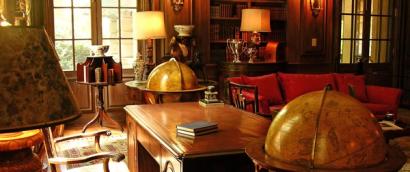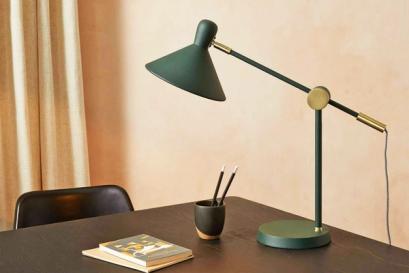

The sporting antiques fit for a gentleman
Because it's never too late to start your collection....
Words: Gentleman's Journal
Antiques relating to British Field Sports are an increasingly popular and valuable niche for collectors and they have the unusual advantage that they are not confined to a cabinet but can still be used as intended. With the help of some of LAPADA’s key antique dealers, we’re bringing you a guide to everything you need
Flask by The Gorham Silver Company, 1900, £3,900 from Bentley’s London
Hip flasks come in a variety of styles and were traditionally made of silver. Glass examples, which do not taint the taste of the alcohol, are clad in leather or crocodile skin for protection and often have gilt-lined silver beakers to form the base. Bentleys have a rare and impressive flask made by the American Silversmiths, The Gorham Silver Company in 1900 (illustrated). The silver is woven as fine basket-weave and the flask is finished with a spiral fluted stopper and costs £3,900.
Flask by The Gorham Silver Company, 1900, £3,900 from Bentley’s London
Novelty hip flasks are rare and sought after. Examples disguised as books with removable corners concealing the top were retailed by Alfred Dunhill in the 1930’s. The book was suitably titled, “A Pleasant Surprise.” As specialists in this area, we have some brilliant examples such a flask disguised as a crocodile skin covered diary (illustrated) which costs £2,400. These flasks were popular during Prohibition.
Crocodile skin covered diary flask, £2,400 from Bentley’s London
Crocodile skin covered diary flask, £2,400 from Bentley’s London
Butt-markers, or peg finders designed to choose your peg at the start of a day’s shooting, are a field that command substantial prices. The silversmiths J.C.Vickery, Thornhill and Sons and Asprey all produced ingenious, and often patented, examples from the 1890’s to the 1930’s. Asprey’s Position Finder, disguised as a shotgun cartridge but containing 8 numbered pegs was made in silver, gold and plated versions.
Vintage leather cartridge bags and cartridge magazines, shooting sticks and gun cases are being bought to decorate gun rooms and “man-caves” along with Campaign Furniture and Taxidermy.”
Mille Miglia Porsche 550 Spyder 356 1954, £3,500 from Antikbar
For people with a passion for sport, posters featuring historical achievements and past events are a great way to decorate and provide for further appreciation. Some people collect posters related to particular sport, while others focus on specific events. Skiing and cycling are the most widely collected sporting posters and, in terms of events, the Olympic Games takes the lead for collectable posters. Even within their chosen sport, some collectors tend to focus only on a race, event or a venue such as the Tour de France for cycling and Chamonix for skiing.
Posters for some sporting events are quite rare; for example, event posters for Mille Miglia car races are very scarce and highly sought after and early Olympic Games posters usually command a premium price.
For those looking to collect for investment purposes, AntikBar’s advice is to focus on well known venues or events, such as the Monaco Grand Prix, Isle of Man TT Race, Wimbledon and St Moritz, to name a few. The featured poster from AntikBar’s collection is an original 1954 poster issued by Porsche to promote their victories in the XXI Mille Miglia race. The rare combination of an iconic brand name with a famous race makes this poster very special.
Before the advent of television, posters were the most effective and broad-reaching medium for advertising and propaganda. Designed to grab attention, they had to deliver a message using minimal words with maximum visual impact. Talented designers developed spectacular images that exuded glamour and style or rallied support for new victories. Being very topical, vintage posters absorbed the art styles and reflected the fashions that capture the essence of their era.
This combination of appealing design and social history makes original vintage posters desirable as collectable artworks, which are widely recognised as a sound investment that appreciates over time. The great variety of subjects, style and prices make them suitable for both new and experienced collectors and those looking for a single investment to enjoy everyday on their wall.
If you would like to learn more about starting a collection or about original vintage posters in general, AntikBar regularly holds “Introduction to Collecting Posters” talks at their gallery. They also provide advice on creating collections and conduct searches for particular posters of interest for clients.”
Malloch Brown trout trophy fish model, 1911 from Manfred Schotte
“When I first started dealing in fish trophies the main trade was the interior decorators market. This soon changed and collectors started buying; at first, stuffed or prepare ‘taxidermy’ fish.
The carved wood examples where mainly purchased by American decorators who very often took these models off their original backboards. If no note of the legend was made the origin was lost. In the antiques boom of the 1980s all models, taxidermy and cast models but especially carved wood models started increasing in price quite drastically.
Today there is still a strong market for fish trophies but the pieces with the legend intact tend to be the most valuable. Of course, record size fish and fish caught by known personalities are very popular.
To beware of fakes goes without saying. Taxidermy pieces are the most popular to be copied, often with labels of well known taxidermists like Cooper, Homer and Rowland Ward. Plaster cast models by Hardy or Malloch in barrel-domed cases are not easily copied.
Wood models where carved by professionals and amateurs – A typical fish by Malloch of Perth would be a ¾ model mounted on a framed, painted backboard with hand written legend. Most of the carved trophies are fairly flat or half models. The best of these are the fish often referred to as ‘Fochaber fish’ carved by John Tully and painted by Miss Isabella Russell. The very early models where most probably carved and painted by John Russell, Isabella’s father.
The Fochaber fish are probably the most desirable to collectors as the fish were very well carved and painted to a highly realistic standard. Some of these fish bear the stencil mark of Farlow, the fishing tackle retailer who probably took orders from successful fisherman wanting a trophy. To have a fish carved, you had to supply a brief description of colour, measurements of length, girth and weight and the Tulley’s would produce a very good likeness of the caught fish.
There are many contemporary model makers today who produce fantastic works of art. To learn more about carved fish find a catalogue of Simon and Edwina Brett’s exhibition of Carved Wood Fish Models, the first and possibly only exhibition of its kind, 24th September 1988 and Ronald Swanson’s book, Fish models, Plaques and Effigies.”
“The British have a very close affinity with all things nautical. For centuries we have been racing each other and pushing the boundaries to go faster and point higher than the opposition; whether it be in the glorious J class of the early America’s Cup or today’s flying machines that Sir Ben Ainsley hopes to bring the cup home in. The British also have a love of collecting, which makes Montague Dawson’s paintings of classic racing yachts in the Solent, highly prized by their owners as they do not come to market very often.
This watercolour entitled First Home sums up the success of our yachting Olympians in Rio as well as the country’s love of classic yachts and all things nautical. This classic yacht with graceful lines and beauty sailing to the finish line in the Solent sums up what I feel was the golden era of yachting, which many yacht designers today are striving to replicate. There are more classic yachts being built today for racing than ever before, as are classes of One Designs from years past, with restoration of the originals as popular as new builds.
Collecting is a passion for many of us and can be all consuming, with the need to find and purchase the next item a major priority. There is nothing better than tracking down a ‘must have’ and hanging it on the wall.
This classic yacht sailing to the finish line in the Solent sums up what I feel was the golden era of yachting with graceful lines and beauty that today many yacht designers are striving to replicate. There are more classic yachts being built today for racing than ever before. The classes of One Designs from years past are also seeing their numbers swell, with restoration of the originals and new builds alike.
This particular watercolour is of a One Design day boat sailing in a brisk wind with the tide opposing. Collecting is a passion for many of us and can be all consuming with the need to find and purchase the next item a major priority. There is nothing better than tracking down a ‘must have’ and hanging it on the wall.”
A selection of antique walking canes, Victorian, c.1870-1900 from Michael German Antiques
“As specialists in antique walking canes, we have a unique and varied range of canes. These antique ‘cricket canes’ are a nod to the refinement and etiquette with which gentleman would dress to watch the sport in the Victorian era. The modern game continues in the same cut and thrust vain, but the genteel element in the fast matches of today is something of the past.
This collection of Victorian walking canes all hand carved, painted stained or polished with cricketing symbols, hand and ball, bat and stumps would have accompanied the gentleman of old as he sat and enjoyed the beautiful game, played on the village square to the splendour of Lords.”
Image courtesy of Hatchwell Antiques
“Aeronautical pieces have been becoming more collectable over the past decade, flight has always been something mankind has been interested in.
The period of the aeronautical collectables range from the end of the 19th century to the 21st century. The beginning saw collectors of airships and dirigibles, Zeppelin being the most desirable. WWI collecting in this area focuses on early British, German and French aircraft. In-between the wars was the Schneider Trophy era, this creates great interest with collectors. Of course WWII, with classic military aircraft, names such as Mustang, Spitfire and Messerschmitt need no introduction.
It does not stop there, the Jet Age, a period which is very popular today and is what we specialise in extremely popular with collectors as is the Space Age with specialist auctions at Bonham’s and Sotheby’s.
We find that our clients get excited by this area of collecting. Most of these individuals work in the scientific and financial industries and like the mix of the technology with the aesthetic they find these items more approachable than other areas of collecting such as contemporary art.
It is a good area to start collecting in since the pieces not only have an interesting history, but also look great in modern interiors.”
Antikbar, Wick Antiques, Michael German Antiques and Hatchwell Antiques will be exhibiting at this year’s LAPADA Art & Antiques Fair, bringing with them their fantastic sporting antiques as well as a variety of works from other areas of collecting. If it’s more than sporting antiques you’re looking to source at the Fair, LAPADA has expert dealers in jewellery, furniture, carpets, tapestries, antiquities, clocks, ceramics, silver and fine art. Approachable as they are knowledgeable, LAPADA dealers are always pleased to share insights into the works they offer and their provenance.
The dealers have pieces available all year round from lapada.org, the leading online market place for sourcing authentic art and antiques from trusted LAPADA credited dealers.


